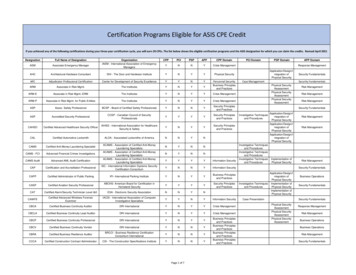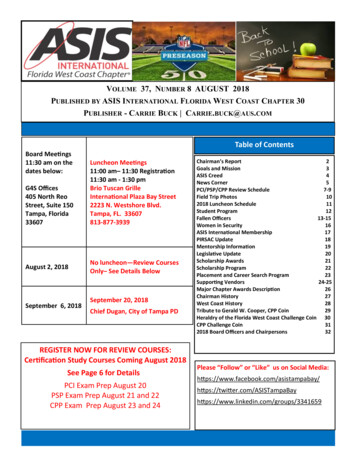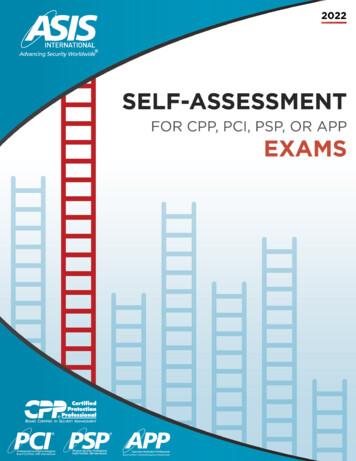
Transcription
RETHINKING THE INTELLIGENCE CYCLEFOR THE PRIVATE SECTORBy: Daniil DavydoffAuthor Bio: Daniil Davydoff is manager of global security in-telligence at AT-RISK International and director of social mediafor the World Affairs Council of Palm Beach, Florida. Davydoff’swork has been published by Foreign Policy, Risk Management, The National Interest, The Carnegie Council for Ethics inInternational Affairs, and RealClearWorld, among other outlets.His views do not necessarily reflect those of his company or ofASIS International.What is the intelligence cycle and why do we use it?Successful security risk management involves careful planning and preparedness rather than ad-hoc crisis response.Successful intelligence analysis requires something similar,and for specialists in this field the intelligence cycle serves asa planning and preparedness blueprint. But just as any setof guidelines must be regularly updated to be effective, theintelligence cycle needs to be reevaluated for its new life incorporate security. As a tool that has been perfected in thepublic sector, the cycle must adapt to private sector realities,including new consumers, new requirements, limited resources, and, at the core, a new mission.There are many ways to describe the intelligence cycle (or“the cycle” as it is sometimes referred to). In short, it is both atheoretical and practical model for conducting the intelligenceprocess. Although there are many variations, the cycle usuallyconsists of six steps: planning and direction; collection; processing; analysis and production; dissemination; and evaluation andfeedback.In one imagined scenario, these steps would be implemented inthe following manner:The head of corporate security reports from a meeting ofexecutives that the company is planning to build a facility inanother country. Senior leaders need intelligence on securityrisks around the planned site, and you agree to create a reporton crime, terrorism, and natural disaster risks in two weeks(planning and direction). As head of the intelligence team, you
Figure – Key Steps ofthe Intelligence Cyclefind raw information from local mediareports, law enforcement records1. Planningfor the area, and credible di& Directionsaster risk databases (collection). After considering thereliability of the sourcesand converting the rawdata into easy-to-readgraphs (processing),you decide whichinformation to use.Now it’s time to write6. Evaluationthe actual report& Feedback(analysis and production), and submit it viaemail and hardcopy tothe interested company’s decision makers(dissemination). Via thehead of corporate security,5. Disseminationyou check in two weeks laterto find out how the report wasreceived (evaluation and feedback).Much of the criticism has decried thecycle’s oversimplification of theintelligence analysis process2. Collectionand its inaccuracy. Are thereenough steps? Who actually drives the cycle? Isthe cycle unidirectionalor does it really flowboth ways? These andmany other questionsare routinely discussed3. Processingregarding the cycle’susefulness or need forrevisions.This begs the questionof whether a reevaluation is needed. Somewould make the casethat rethinking the model is4. Analysisunnecessary. The intelligence& Productioncycle was always meant as arough model with the key being thefluidity of its application to any environment, whether public or private. It is true thatmany of the current challenges facing the traditionalintelligence cycle model can be resolved by adaptable analystsand good training. Having said that, considering the nature ofthese challenges is itself a needed exercise.This approach is useful across most typesof intelligence work, whether protective intelligence or global security intelligence. In recent years, eveninvestigators have adapted the cycle to serve their needs.Of course, the intelligence cycle’s usefulness is not the onlyreason that it is has become both the standard reference pointfor analysts and a framework for many private-sector analysttraining programs. When government employees move intothe private sector, they bring the cycle with them.Although the cycle has faced myriad criticisms, the premise ofthis white paper is that private sector analysts have a specialset of obstacles and considerations at each step of the model.This is due to some of the elements that distinguish the private sector from the public, including (but not limited to):At the lower levels of the corporate intelligence ladder,intelligence analysts come from a diversity of backgrounds.One can find among them English and psychology graduates,young regional specialists, data-savvy social media analysts,and budding think-tankers. The middle and top sections of theladder are starting to diversify, but it is well known that formermilitary and three-letter-agency employees still are hired disproportionately within corporate security departments. Intelligence leaders, therefore, have been raised on the intelligencecycle, and whether or not they innovate in other areas, manyconsider the cycle a fundamental model to follow. The wider variety of hierarchies and reporting linetypes Different rates and priorities concerning technologyimplementation Higher variation in workplaces Widely different organizational goals Potentially faster rates of change, growth, andorganizational restructuring Limited resources for security in relation to otherinstitutional focus areasChallenges facing the intelligence cycle modelThere’s a degree of uncertainty regarding the origins ofthe intelligence cycle. Depending on whom you ask, it wasconceived around the time of the French Revolution or duringWorld War I. In any case, it seems to have become an intelligence community staple in the Cold War period, and duringthat time, there was no shortage of criticism of the model.There is an important caveat to these distinguishing characteristics, namely that they are trends rather than certainties.Regarding limited resources, for example, there are many government agencies that would dream of having the resourcescommanded by protective intelligence teams for some majorcompanies.2
Steps of the cycle and the private sectorhad to explain her role as advisor and inform the individual thathis primary responsibility was to use the gathered intelligenceto inform his decisions.To dig deeper into how the intelligence cycle may be affectedby these factors, we can consider each phase of the cycle inturn.Step: 2 – CollectionStep: 1 - Planning and DirectionFor most intelligence analysts, the collection step will be themost obviously different between the public and private sectors. In short, the private sector analysts need to be more versatile to be effective. Whereas government analysts are oftenhyper-specialized, with some focusing on human intelligence(HUMINT) and others focused on signals intelligence (SIGINT),private sector teams are, in some sense, “any source any time.”This is partially due to raw team size. Even the wealthiest corporations do not usually devote enough resources to securitygenerally, and certainly not to maintaining large intelligencedepartments.Establishing the recipient’s intelligence requirements is one ofthe most critical steps, because understanding customer needsaids the team in structuring a project and pursuing certain typesof intelligence. In the public sector, this step is fairly straightforward. A government institution or senior official has an “ask” ona security issue, and intelligence personnel pursue the information, whether the subject is government instability, terrorism, oranother threat. In the private realm, intelligence consumers mayhave only elementary levels of knowledge on threats, requiringbasic research from intelligence teams. Christopher Broomfield,a global security and threat analyst for Carnival Corporation,and former intelligence officer with the U.S. government, notesthat:The leanness confers both advantages and disadvantagesonto private sector intelligence gathering. On one hand, smallteams mean risks on the intelligence continuity front. Shouldone analyst leave a three-letter agency in Washington, theimpact will likely be less severe than the departure of one offour analysts for a large multinational. The latter probably has agreater amount of wide-ranging knowledge on critical sourcesthe company needs to follow, as well as a better understandingof operations at the company. . . private sector analysts must uncover security issues andevents which are not necessarily apparent but could impactbusiness operations, and be able to quickly find and providerelevant findings for decision makers. In addition, they oftenneed to address stakeholders who are not familiar withspecific transnational issues and explain how these couldpresent challenges to the business environment.On the plus side, having fewer resources encourages analyststo become experts in utilizing open-source intelligence (OSINT)to a greater degree than those in the public sector. It is commonly stated that 90 percent of critical intelligence is opensource, so this is a major strength. In fact, it is a strength even inareas where one would think that publicly available informationis insufficient. As Audrey Villinger, a senior manager with thefirm Security Industry Specialists, Inc., puts it, “Even in lawenforcement and crime, open-source intelligence is a big deal.People don’t call 911 anymore, they don’t stick around for witness statements, they tweet about it.” To be sure, law enforcement agencies (among others) are now relying on the Twitterfeed themselves, both through their own resources and byworking with the small industry of data-mining firms that havearisen. Yet as new open sources and feeds pop up, it is typicallythe private sector that still adapts to the new technology first.In some cases, private sector consumers may not have a goodnotion of what is needed, so the process should be reversed,with the corporate analysts being more proactive to “push” theirideas in creating a research plan. This issue is not unique to theprivate sector, but is typically more pronounced. It is sometimesmost apparent in the protective intelligence realm because evaluating individual threats requires specialized training in forensicpsychology, among other disciplines. AT-RISK International wasonce working with an organization that was concerned aboutthreats made by an employee and references made to “AllahuAkbar.” While the client asked us to investigate the employee’sdissatisfaction in the workplace and the Islam connection, ourexperience in threat assessment told us we needed to also pursue other directions. After digging through the subject’s socialmedia posts, we found that he had undergone recent changesin mood and behavior, and ultimately the focus of the assessment needed to be psychological in nature.Yet another opportunity (and to some degree a requirement)for private sector analysts is networking. Of course, filling outthe Rolodex or connecting on LinkedIn is helpful to governmentemployees, too. But using those contacts for the purposes ofintelligence collection is something corporate analysts andconsultants can do with more ease despite the greater individual effort necessary to expanding networks. Broomfield, ofCarnival, points out that analysts must be “cognizant of proprietary issues, but these issues are nothing like the scrutiny orrestrictions of the public sector’s classified environment.” UsingA colleague from a top global technology services firm recentlynoted an even more fundamental problem. After transitioningfrom several years in the intelligence community and startingher position as a lead threat and risk analyst in the commercialspace, she realized that some of her company’s stakeholdersdid not understand that they were consumers. Upon receivingher reports, at least one of them thought he needed to edit thereport and give it back to her team. In the end, my colleague3
Step: 5 – Disseminationpersonal networks as sources is also more critical absent government agency resources. Some companies solve this problem by relying directly on government and law enforcementcontacts to eliminate lag between the occurrence of a majorincident and their intelligence feed. On the travel security front,networks of travel risk managers or even analysts themselvesnow voluntarily share information on travel warnings, achievingsomething similar.The nature of the audience matters a great deal near the end ofthe intelligence cycle just as it does at the beginning, when theinitial requirements are being discussed. At the disseminationstep—when findings are finally given to the recipient—privatesector intel teams must once again contend with consumerswho are not used to typical intelligence deliverables. Innovationon delivery is essential.Step: 3-4 – Processing, Analysis, and ProductionThere are differences among the typical public sector consumers on this front, with some requiring briefings or presentations,but it is safe to say that most are at least accustomed to thereport format. This is not always so in the private realm. Outside of the corporate security department, many senior leaderswith MBA degrees last read a long and detailed report in gradschool. For key corporate decision makers, storytelling throughPowerPoint—or similar presentation tools—is a necessity.And when it comes to this kind of storytelling, bullet points onslides are not enough. Intelligence findings need to be visualand interactive, and most of all emphasize the quantitative formaximum impact. In the private sector, there are variationsamong industries that may not be as significant in the publicsector. According to Villinger, of Security Industry Specialists,Inc., tech firms, for example, tend to have very high aestheticrequirements.The traditional intelligence cycle model is a step-by-step approach, with the production and analysis phase following processing, which in turn follows collection. Whether the analyst isworking for the public or private sector, most would agree thatthis is a very naïve way of describing the process. In reality, thesteps are fluid and production of analysis may run concurrentlywith information gathering or even start before intelligence isfully collected. In practice, then, steps three and four are frequently combined.This is not unusual within the government or within thecommercial space, though the private sector may create morepressure to “just start writing.” The resource and specializationissue already mentioned is partially responsible. Small teams ofcorporate intelligence analysts often must cover more groundin less time. In one day, an analyst may have to jump fromreputational risk in Latin America to terrorism risk in Europe tointellectual property risk in Asia. Furthermore, private sectorconsumers such as traveling employees sometimes are lessknowledgeable on intelligence matters than government customers, so it can be easier for corporate security analysts to juststart writing what they know and fill in the details later.It is worth noting that, generally, the government tends toinvest more resources in technology for collection than technology for presentation, whereas the reverse is sometimes truein the private sector. It is, therefore, possible that the gap inwhat dissemination means between the two sectors will onlyexpand over time, and the intelligence report will continue tobe standard within the government even as private companiesmove to radical technology such as virtual or augmented realityfor presentations.The more extensive use of OSINT in the private sector has also,paradoxically, introduced both greater certainty and greater uncertainty to analysis, depending on the case. Instead of weighing a “raw” diplomatic cable against local reporting as somegovernment analysts can do, private sector employees whoseremit is country risk might have to decide which of ten mediastories and blog posts about a certain security incident haveit right. Judging source reliability is just as critical within thegovernment, and some would say that oversights in this areahave been responsible for some of the most notable intelligencefailures of recent years. Still, the reality for some small privatesector intelligence teams is that they have few local sources atall, making accurate judgment tougher to some degree.Step: 6 – Evaluation and FeedbackDepending on whom you ask, the intelligence cycle has a sixthstep—evaluation and feedback. At this juncture, the intelligencecreators receive some sort of response to or comments on theirwork, at least in the ideal world. For many analysts, this step isfrustratingly similar in the public and private sectors in the sensethat they only hear back if something goes awry. If anything, thissilence is more common in the private realm because intelligenceconsumers in business environments are busy creating revenuerather than taking pride in policy or tactical knowledge on a security issue. Sometimes, private sector consumers come back withadditional requests, which means the job is being done right.Frequently, getting feedback requires intel teams to be proactive.Requests for feedback are necessary, but need to be as convenient and quick to fulfill as possible for intelligence recipients.An annual survey is the ideal approach, but follow-up calls onimportant products can also work in a pinch.In other areas, private sector analysts who are used to leveraging OSINT due to the lack of other resources might have ananalytical advantage. Social media monitoring allows protectiveintelligence analysts to have a much better idea of the risk thatindividuals may pose to threatened targets. When combinedwith threat assessment guidelines, social media posts serve ashighly useful indicators for violence.4
What’s next for the intelligence cycle?mission. Whereas government institutions are committed tothe safety and security of citizens at virtually any cost, the coreobjectives of businesses revolve around profit. Security for personnel, assets, or the enterprise must be balanced against costsand revenue goals. Apart from improving methods or makingtheir own lives easier, it is imperative that intelligence teamsregularly assess how the cycle can better fit into these centralcorporate calculations. Only then can intelligence go from beinga “cost center”—a fate often ascribed to corporate securitybroadly—to something that creates value.All these challenges—individually and taken together—aremeant to remind us about the need for constant reevaluationof the cycle. This review, however, is not meant as a call toreplace the model. If anything, thinking about the problemsexperienced by private sector intelligence can help improveefficiency of the analytical process outlined by the cycle. It canalso aid in creating a more realistic and effective training program for new analysts. In that sense, each intelligence teamshould consider not just these issues but obstacles specific totheir own organization.That takes us to perhaps the most important difference between the public and private sectors, and the best reason forreevaluation of how we “do” intelligence: the difference inCopyright 2017 by ASIS International. ASIS International (ASIS) disclaims liability for any personal injury, property or other damages of any nature whatsoever, whether special, indirect, consequential or compensatory, directly or indirectly resulting from the publication, use of, or reliance on this document. In issuing and making this document available, ASIS is not undertaking to renderprofessional or other services for or on behalf of any person or entity. Nor is ASIS undertaking to perform any duty owed by any person or entity to someone else. Anyone using this document shouldrely on his or her own independent judgment or, as appropriate, seek the advice of a competent professional in determining the exercise of reasonable care in any given circumstance.All rights reserved. Permission is hereby granted to individual users to download this document for their own personal use, with acknowledgement of ASIS International as the source. However, thisdocument may not be downloaded for further copying or reproduction nor may it be sold, offered for sale, or otherwise used commercially.The information presented in this White Paper is the work of the author, and does not necessarily reflect the opinion of ASIS, or any ASIS member other than the author. The views and opinionsexpressed therein, or the positions advocated in the published information, do not necessarily reflect the views, opinions, or positions of ASIS or of any person other than the author.1625 Prince StreetAlexandria, VA 22314 1.703.519.6200asisonline.org5
intelligence cycle needs to be reevaluated for its new life in corporate security. As a tool that has been perfected in the public sector, the cycle must adapt to private sector realities, including new consumers, new requirements, limited resourc-es, and, at the core, a new mission. There are many ways to describe the intelligence cycle (or










